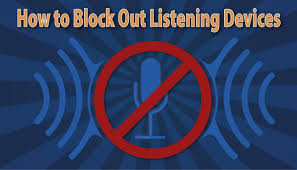Blocking Listening Devices

You can sweep a room for listening devices as much as you like but there is just no guarantee you will find them all. You might also be in a space where checking for hidden
microphones is not practical.
If this is the case then your best option is to try to block the sound from reaching any listening device that might be nearby.
Three ways to block listening devices:
Distort the sound that reaches the device Block the sound completely Transmit another sound to mask the sound It is this last option that we will talk about in this article because it requires the least amount of effort to put into action. You just use a handy little device called an audio jammer.
Read on to find out how these devices work and how to use them.
How Audio Jammers Block Listening Devices Audio jammers are small, usually mobile, devices designed to interfere with the way listening devices operate. When you switch on an audio jammer it masks the sound of a conversation, ruining recordings and impeding live audio surveillance.
The way these do this is by emitting white noise. Some people think of white noise as static on a radio or old TV and this is nearly correct. White noise is a sound that contains all the audible audio frequencies played at the same time and at the same amplitude.
This means that it contains all the most bassy sounds we can hear to all of the highest pitched sounds we can hear and everything in between, at once, at whatever volume you choose.
It’s not immediately obvious to most people why this would stop a listening device from working until you take a look at how a microphone works. There is a small diaphragm in every listening device which vibrates when sound waves hit it.
These vibrations move a magnet near a coil of wire which converts the wave energy of the sounds into changes in a small electrical current. When the diaphragm is overloaded with white noise from an audio jammer, other sound waves, such as someone speaking in the same room, are lost in the vibration so it is very hard to pick out voices when listening to the recording.
You might have heard of sound engineers picking different frequency ranges for certain instruments when they are mixing a song. Imagine a bass drum and a bass guitar playing at the same time.
Sometimes the frequencies of these instruments are the same when recording, so when those sounds reach our ears it is difficult to tell which is which because of the way the diaphragm in our ear vibrates. One part of the eardrum (diaphragm) vibrates for each frequency.
Recording artists try to make sure that instruments’ frequencies don’t overlap too much for this reason because it makes the individual instruments sound quieter. This is exactly what we want to happen when we are trying to block listening devices, which is why audio jammers emit sounds at all frequencies.
How to use an audio jammer to block a listening device Audio jammers are so convenient because they are super portable and battery-powered. You can keep them in your pocket or bag and just switch them on when you are having a sensitive conversation, there is no setup necessary.
They have effective jamming ranges of up to 150 sq. ft. which is plenty for most rooms, you are welcome to shop around for a more powerful unit but we have found that more powerful units are so loud they make having a conversation quite difficult. We like to think we have a product that strikes a happy medium.
Make sure to test the effectiveness of the jammer in the environment it will be used.
Go to the room you suspect might be bugged and try to record a conversation when the audio jammer is on. If you can understand the conversation there are a few things you can do: Speak more softly Have the conversation closer to the audio jammer Turn up the volume on the audio jammer Experiment by having conversations at different distances from the jammer and see what effect that has.
The jammer is most effective when it is placed right next to the microphone.
Now obviously if you knew where the microphone was it would be easy to block it entirely but if you haven’t managed to find the physical listening device but still want to cover your bases, just put the jammer in a likely place and have your conversation elsewhere in the room.
A good idea is to imagine where you would put a listening device in a room and work from there. The underside of work desks, inside drawers, and disguised as regular office items are all common places to hide eavesdropping devices.
Have a look at our hidden audio section to find some inspiration about what can be done to disguise audio surveillance.